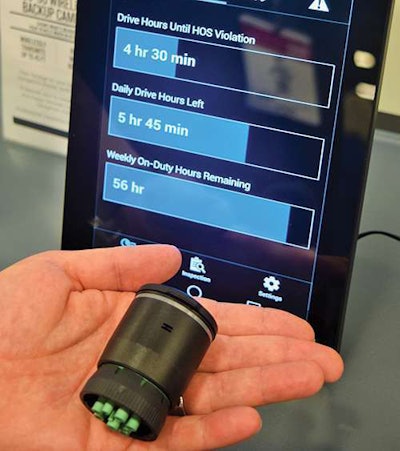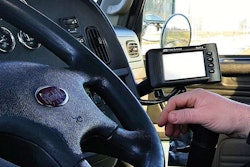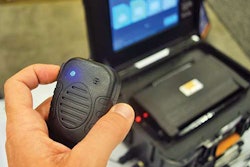 The Garmin company’s baseline ELD pairs the ECM plug-in dongle shown with software on a tablet or smartphone. It’s one of the few ELDs that is available without an ongoing monthly fee. Duty status changes, as in other devices, are made with quick interactions with the touch screen display on a tablet or smartphone.
The Garmin company’s baseline ELD pairs the ECM plug-in dongle shown with software on a tablet or smartphone. It’s one of the few ELDs that is available without an ongoing monthly fee. Duty status changes, as in other devices, are made with quick interactions with the touch screen display on a tablet or smartphone.While electronic logs generally automate parts of log keeping and in some ways simplify the rest, they still require direct driver involvement in most duty status changes.
As with paper logs, drivers using electronic logs are in control of all duty status inputs. The exception is the drive line, which can function automatically. It’s also the only status the driver will be unable to edit directly through his driver login.
To minimize the need for annotations required with any edit, the long-in-practice habit of “catching up the log book” by drivers will fall by the wayside. With no pencil to be pushed across paper, as long as the device is operational and open, duty status changes happen with the simple push of a button in real time.
The drive line can be edited only from the administrator’s account to classify an unassigned driving event or drive time as personal conveyance or a yard move, or to reassign time to the correct driver. Drive time cannot be reduced. Any edits made from the administrator account – the back-office login – must be certified as accurate by the driver, which occurs through the driver’s user interface of the ELD when the edit is made.
Download the full ELD Buyers’ Guide

Click here to download the full version of the Overdrive ELD Buyers’ Guide, updated with how your business can choose an ELD for your business.
An independent owner-operator will have two separate logins for the system: one as a driver, the other as the administrator. An independent lacking two email addresses may need to get a second one. Many systems require unique addresses to associate with the logins as administrator and driver-user.

When it comes to the look and feel of the user interface that e-log provider companies are required to produce, the ELD final rule leaves plenty of room for variation. It did, however, make the requirement that devices display a graph grid like that in paper logs.
Some ELD makers, for instance, offer support for the variety of intrastate rules that exist, though there is no requirement in the ELD mandate final rule for them to offer such support and truckers can utilize any federally registered and self-certified device for intrastate-hours logging. Most, though not all, states have adopted the ELD mandate for their intrastate haulers.
In the states where intrastate markets are comparably large, notably Florida, Texas and California, deadline delays were on offer, however. In-state Florida haulers have until the end of 2018 to adopt an ELD if covered under the rule. Texas intrastate haulers can continue to use paper logs until December of 2019. California was still mulling its final deadline as of press time, with a proposed date of late 2020 looking likely.
Special driving categories
Yard moves functionality was specified in the ELD final rule as a way for carriers to move vehicles around company terminals without automatically triggering an on-duty driving status. Yard-moves mode for particular drivers will be enabled from the administrator account and then selected by the driver when making a yard move – the default status for a yard move is Line 4, on-duty not-driving.
Personal conveyance uses of the truck while off-duty also are enabled from the administrator account for drivers. The personal conveyance mode then can be selected by the driver using the truck for personal reasons during off-duty periods. Once selected, the default duty status is off-duty for the ELD for as long as it’s selected, including when in motion. GPS refinement is reduced from a one-mile radius to 10 miles.
Various hours exemptions and special rule variants such as those pertaining to the 30-minute break and rules for oilfield operations can be handled as they have been, FMCSA’s rule states, via notes sections to the logs. However, numerous ELD providers support special oilfield rule sets, including Apollo, E-Log Plus, Hutch, Omnitracs’ XRS device and others.









